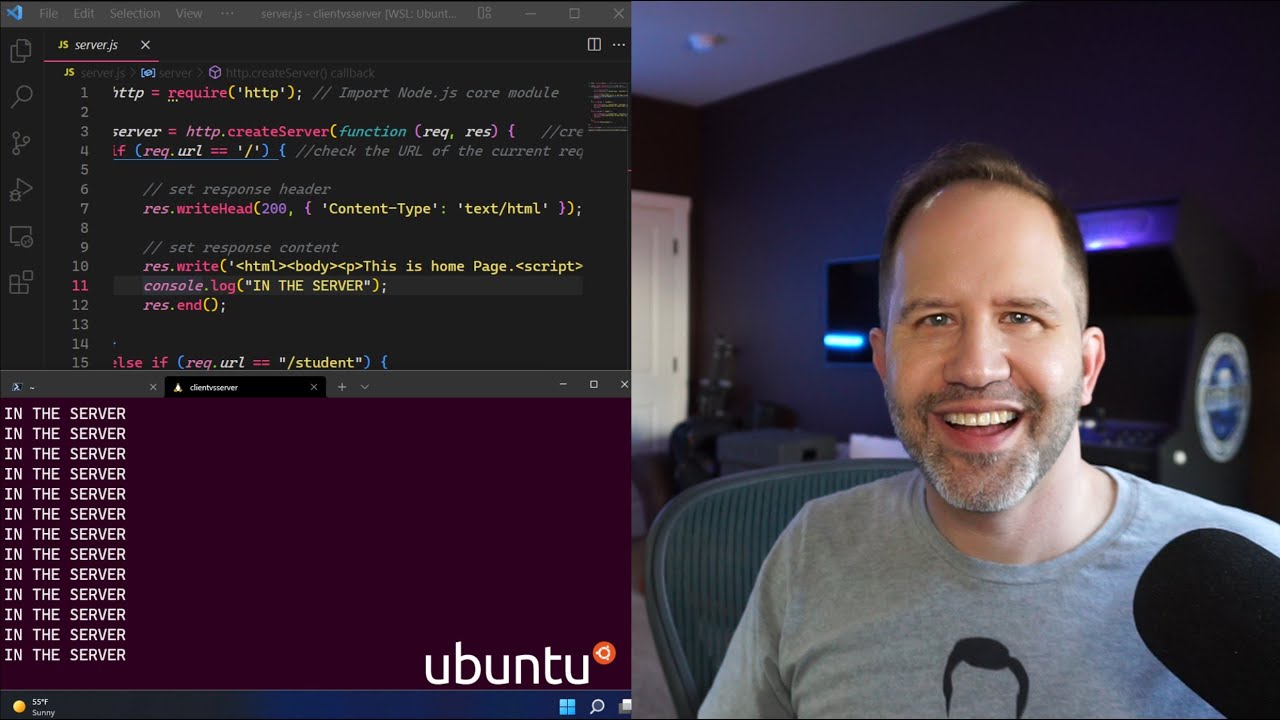Differences between server side scripting and client side scripting
Summary
TLDRThis video from Knowledge 24 explores the distinction between server-side and client-side scripting in software development. It clarifies that server-side scripts require a web server for processing and are used for dynamic page creation and database connections, offering more security as the code is hidden from users. In contrast, client-side scripts are processed by the web browser, execute faster, and are less secure due to code visibility. The video provides examples of each, such as PHP and JavaScript, and discusses their applications, like website customization and form-filling interactions.
Takeaways
- 😀 Scripting is a set of instructions or programs for webpages executed without compilation.
- 📚 There are two types of scripting: server-side and client-side.
- 🤔 Server-side scripting requires a web server for processing, while client-side scripting uses the web browser.
- 💻 Client-side scripting is all about the web browser executing the code, without interaction with the web server.
- 🔗 Server-side scripting is used for dynamic page creation when a user's browser makes a request to the server.
- 🚀 Server-side scripts connect to databases, unlike client-side scripts.
- 🖥️ Server-side scripts execute on the server, with results displayed in the browser; client-side scripts execute and display in the browser.
- 🛡️ Server-side scripting is more secure as the code is not visible to users, while client-side code is visible.
- 🔍 Server-side scripts access server settings, while client-side scripts access local user computer settings.
- ⏱️ Server-side responses can be slower due to remote processing, but client-side scripts are faster as they execute in the browser.
- 🛠️ Server-side scripting is used as a back-end solution, whereas client-side scripting is used for front-end functionalities.
- 🔑 Examples of server-side scripting languages include PHP, JSP, ASP, Python, and Ruby; client-side scripting is exemplified by JavaScript and VBScript.
- 🎨 Server-side scripts are used for website customization, database connections, and dynamic page creation; client-side scripts are used for user interactions like form-filling.
Q & A
What is scripting in the context of software development for webpages?
-Scripting refers to a set of instructions or programs for webpages that are executed without compilation, typically used for dynamic content and interactivity.
What are the two main types of scripting mentioned in the script?
-The two main types of scripting mentioned are server-side scripting and client-side scripting.
How does server-side scripting differ from client-side scripting in terms of processing location?
-Server-side scripting involves a web server for processing, whereas client-side scripting is processed by the web browser without interaction with the web server.
What is the role of the web browser in client-side scripting?
-In client-side scripting, the web browser is responsible for executing the code and displaying the results.
Why is server-side scripting considered more secure than client-side scripting?
-Server-side scripting is more secure because the execution code is not visible to the users, as opposed to client-side scripting where the code is visible.
Can client-side scripting be used to connect to a database?
-No, client-side scripting is not used for connecting to a database; this is a functionality of server-side scripting.
What is the impact of server-side scripting on the speed of web page responses?
-Server-side scripting can result in slower responses because the processing is done on a remote web server.
How fast are the responses in client-side scripting?
-Client-side scripting provides faster responses because the code execution and result production occur on the web browser itself.
What are some examples of server-side scripting languages mentioned in the script?
-Examples of server-side scripting languages include PHP, JSP, ASP, Python, and Ruby.
What are the typical applications of client-side scripting?
-Client-side scripting is typically used for form-filling, user interactivity, and reducing server load by handling some functionalities on the client side.
What is the primary purpose of server-side scripting in web development?
-Server-side scripting is primarily used for website customization, database connection, and the creation of dynamic pages.
Outlines

This section is available to paid users only. Please upgrade to access this part.
Upgrade NowMindmap

This section is available to paid users only. Please upgrade to access this part.
Upgrade NowKeywords

This section is available to paid users only. Please upgrade to access this part.
Upgrade NowHighlights

This section is available to paid users only. Please upgrade to access this part.
Upgrade NowTranscripts

This section is available to paid users only. Please upgrade to access this part.
Upgrade NowBrowse More Related Video

JavaScript Tutorial for Beginners | JavaScript Free Course | by Rahul Chaudhary

Web Development Tutorial - Server-side scripting

Client-side vs Server-side, Front-end vs Back-end? Beginner Explanation of JavaScript on the Web

#26 - Rendering: Rendering Nedir? SSR ve CSR Nedir? - Sıfırdan İleri Seviye Next.js v13

Cross-Site Scripting Attacks: What You Need to Know Now

ServiceNow Scripting Tutorials | Scripting in ServiceNow | ServiceNow Scripting Full Course | HKR
5.0 / 5 (0 votes)